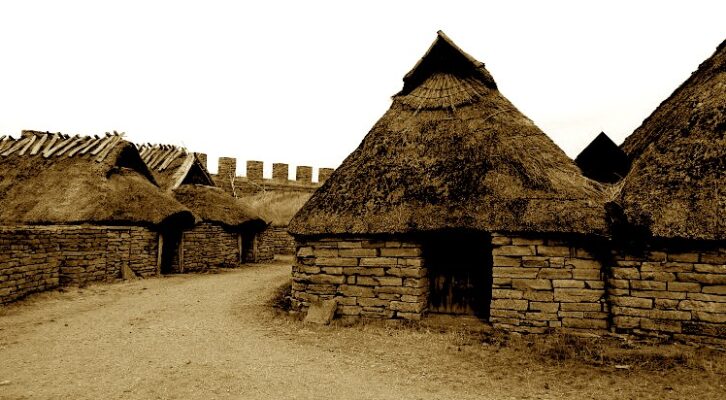
How the Neolithic Age Marked the Beginning of the Modern World
John Charles Chasteen on When Homo Sapiens Became Human, For Better and For Worse
Finally, we can say that if male aggressiveness and sporadic violent competition do seem to be general aspects of human nature, group violence, along with social inequality and subordination, are generally not—at least not when we live in the social conditions under which we evolved as a species. Those conditions changed as the domestication of plants and animals ended the Paleolithic period and began the Neolithic period, our next stop.
*
Around 10,000 BCE the Ice Age (or, more properly, “last glacial maximum”) ended after a frigid hundred thousand years. The entire period of modern humans’ evolution and expansion around the globe had occurred during a protracted sequence of glaciations and intermittent thaws. Foraging Homo sapiens had become the world’s most widespread apex predator, occupying all the continents except for Antarctica.
To tell the Neolithic story, however, we cannot use a traditional historical narrative.
There was still plenty of ice around, however, when the so-called ice man died in the Italian Alps about 5,300 years ago. We have no idea what his real name was, or even what language he might have spoken. The ice preserved his body until 1991, when he turned up in a snow melt because of recent global warming. He was all there, down to the contents of his stomach, which showed that his diet included cultivated wheat.
The invention of agriculture was a defining aspect of his world, as was his elaborate material culture, including baskets, leggings, shoes, a wood-framed backpack, and a stitched fur coat. He had an unhealed gash in his hand, apparently made while defending himself against an attacker’s copper-bladed ax or flint-bladed knife, not unlike those he himself carried. He also carried a powerful six-foot bow, as well as a quiver of arrows not unlike the one that, in the end, hit him in the back, severing an artery and killing him. His wounds and weapons were another defining aspect of his Neolithic world.
The previous chapter’s rapid overview of the Paleolithic world encompassed hundreds of thousands, occasionally millions, of years. Those vast expanses of time had shaped Homo sapiens as a species, physically and mentally. The big Paleolithic story was evolution. Now we leave evolutionary time behind, however. During the few thousand years of Neolithic time, human bodies changed little. The Neolithic millennia shaped us culturally and socially rather than physically.
The big Neolithic story is the domestication of plants and animals, the so-called Agricultural Revolution. Agriculture may not sound like much of a story, but the Agricultural Revolution changed almost everything. Picture two Homo sapiens standing in their dwelling places, one in 10,000 BCE, one today. Naked, with a haircut, the Homo sapiens of 10,000 BCE will look pretty much exactly the same as the Homo sapiens of today—presuming that you’re imagining this correctly. Except for the two naked Homo sapiens, though, pretty much everything else in the two pictures would have to be different.
One Homo sapiens sleeps under a bush, the other in a high-rise apartment building. The ten-thousand-year Agricultural Revolution was the single biggest cause of the difference. By domesticating plants and animals, we harnessed other living things to serve our purposes, and, through selective breeding, even reshaped them to serve us better. In so doing, we took a decisive step toward material abundance and world domination. The ancient Hebrews thanked their creator God for giving people dominion over other living things. Modern people can credit the Agricultural Revolution.
Now let’s step away from the metaphor of revolution, however. While revolutionary in the sense of hugely transformative, the domestication of plants and animals was neither rapid nor organized. On the contrary, domestication was a diffuse and gradual process, whose accidental character is essential to understanding it. Ten thousand years may be an evolutionary blink of the eye, but it is a long, long time in human terms. No one who lived during this “revolution” experienced rapid change because of it, or even knew that it was happening.
Neolithic time ended before the invention of writing. Neolithic life has therefore normally been studied by anthropologists rather than historians. It lacks personal names, precise dates, colorful characters, and outrageous anecdotes. Thrilling yarns have occasionally survived from the Neolithic world only as myths and legends. The Neolithic story matters not because of its entertainment value but because of how it shaped us.
It made Homo sapiens the world’s dominant species, but also brought war, patriarchy, and all kinds of social exploitation and systematic brutality. To tell the Neolithic story, however, we cannot use a traditional historical narrative. Instead, we must interpret a variable process that began in maybe twenty places and proceeded simultaneously but unevenly over ten thousand years. One element of the timing is crystal clear. The process began as a response to climate change—more specifically, global warming.
The geographic spread of Homo sapiens was predictable as the climate warmed after 10,000 BCE. Thriving edible plants supported more population, but oversized groups are impossible for foragers to maintain, as we have seen. When foraging populations grew, they became centrifugal, spreading out more or less automatically.
And, in locating new hunting grounds, the apex predator Homo sapiens suffered the same lack of constraints as the gorilla in the joke: “Where does an eight-hundred-pound gorilla sleep? Anywhere he likes.” Bad-ass Homo sapiens could live anywhere they could find enough food.
The Neolithic story matters not because of its entertainment value but because of how it shaped us.
By sampling mitochondrial DNA in current global populations, it is possible to trace the Paleolithic migration of Homo sapiens out of Africa along the shores of the Indian Ocean, as far as Indonesia and Australia. Mitochondrial DNA is not organized in the familiar double helix that recombines in every generation, so that children inherit half from their mothers and half from their fathers.
Instead, mitochondrial DNA is inherited fundamentally unchanged across many generations, and it is inherited only from one’s mother. Its stability makes it a convenient tracer of historical migrations. That’s how we know that all living women descend from a “mitochondrial Eve,” a single female ancestor who lived more than 100,000 years ago in east Africa. By the time our migrating ancestors arrived in what is now Malaysia—on their way (although they didn’t know it yet) to Australia—a wide stretch of open ocean confronted them.
Although the evidence has largely disappeared under the waves, we now suspect that some Neolithic people became competent sailors. Archaic humans had never made it to either Australia or the Americas, but Homo sapiens apparently had no trouble. The original occupation of Australia by Homo sapiens occurred before fifty thousand years ago, when it necessitated a significant open-ocean crossing.
Late Paleolithic glacial periods lowered sea levels (locking much of the planet’s water in ice) and uncovered a land bridge between Asia and North America. Now, however, there is persuasive evidence that Homo sapiens peopled the Americas partly by sea, using boats or rafts. Archeologists have excavated an extremely ancient settlement of early maritime-oriented migrants who lived very far south on the Pacific Coast of Chile, almost at the southern tip of South America. Their coastal Monte Verde archeological site is now the oldest confirmed place of human habitation in the Americas.
The Monte Verde encampment of twenty to thirty individuals, like so many early human encampments, stood on the banks of a stream, which eventually flooded and became a bog. By limiting oxygen, bogs preserve organic matter, allowing archeologists to determine that the occupiers of this encampment used half a dozen kinds of seaweed. Unquestionably, the people encamped at Monte Verde lived on intimate terms with the sea.
A look at Oceania, the last part of the habitable Earth to be colonized by Homo sapiens, shows us that some Neolithic sailors could cross thousands of miles of open ocean. These sailors, the forerunners of the Polynesians, settled the archipelagos of the South Pacific, starting from continental Southeast Asia and China. As often happens with prehistoric people, we cannot know what they called themselves.
Our only actual evidence of them is their pottery, recently excavated on islands where they settled. Their Lapita pottery styles were spread from New Guinea across a thousand miles east into the open Pacific Ocean, as far as the island of Fiji. The seafaring that made that possible was done on double-hulled canoes, or large-hulled single canoes with outriggers.
That gets us ahead of our story, though.
__________________________________

Excerpted from After Eden: A Short History of the World by John Charles Chasteen. Copyright © 2023. Available from W.W. Norton & Company.
John Charles Chasteen
John Charles Chasteen is professor of history emeritus at the University of North Carolina at Chapel Hill and author of Born in Blood and Fire, the widely beloved best-selling history of Latin America. He lives in Pittsboro, North Carolina.



















